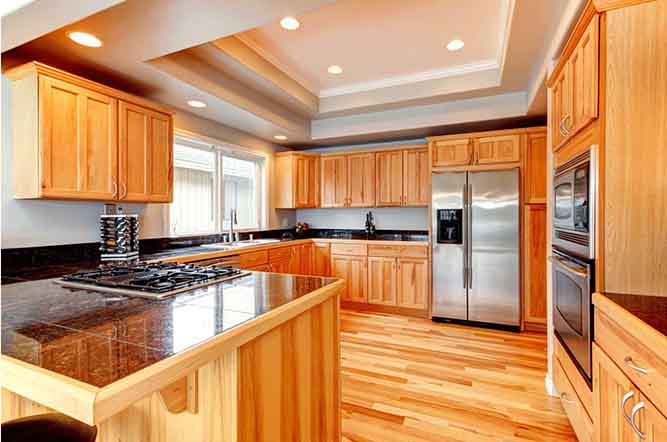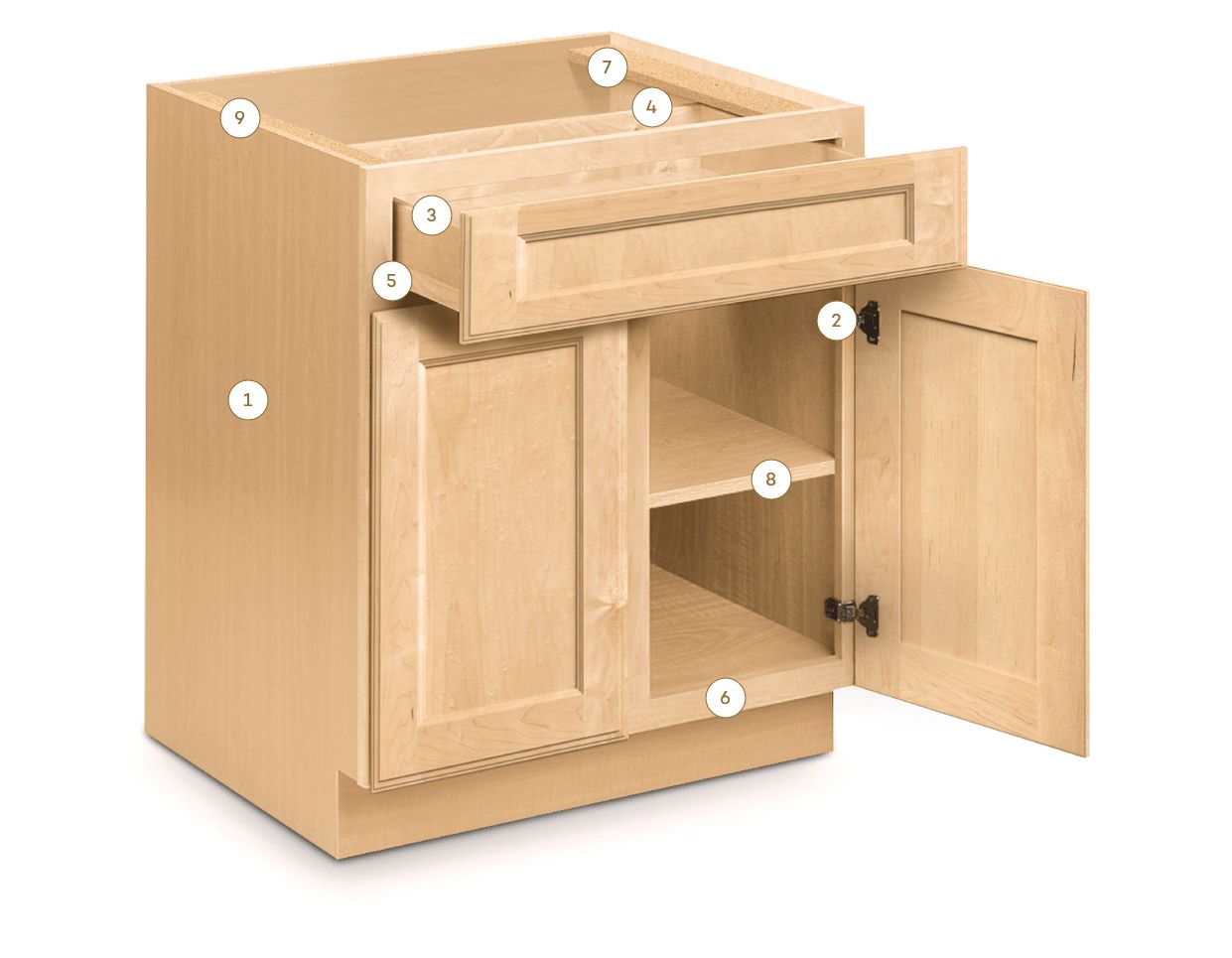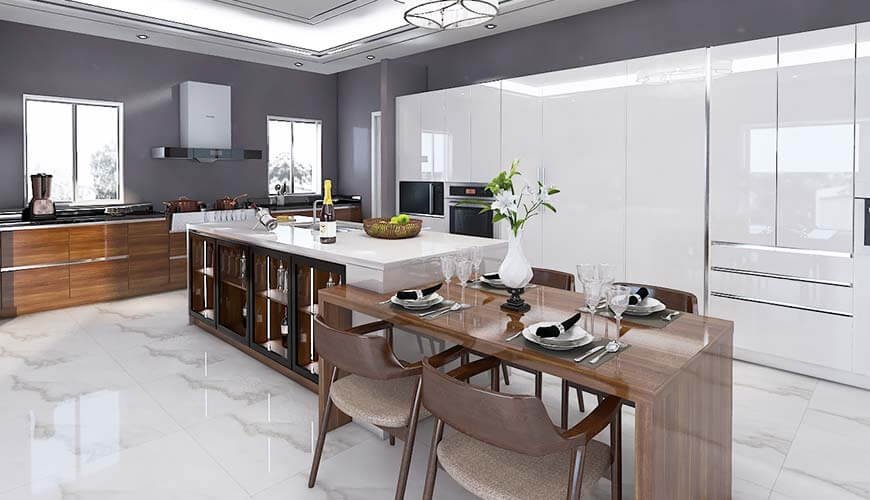Check for wood grain patterns and end grain in the cabinet doors. Real wood will have unique and inconsistent patterns.
Identifying real wood kitchen cabinets can significantly impact your home’s aesthetic and value. Real wood cabinets provide durability, longevity, and a warm, natural look. Fake wood alternatives, like particleboard or MDF, lack the unique grain patterns found in real wood.
Inspect cabinet edges and corners for visible grain and end grain, which are telltale signs of genuine wood. Real wood also feels heavier and more solid compared to synthetic materials. These tips can help you distinguish real wood cabinets from imitations, ensuring you make an informed decision for your kitchen. Knowing the difference not only enhances your kitchen’s appearance but also guarantees lasting quality.
Table of Contents
ToggleIdentifying Real Wood
Knowing if your kitchen cabinets are real wood can save you time and money. Real wood cabinets add value and beauty to your home. There are several ways to spot real wood. Let’s dive into the details.
Grain Patterns
Real wood displays unique grain patterns. These patterns are like fingerprints. No two pieces of wood look the same. Look closely at your cabinets. Do you see lines and swirls? These are natural grain patterns.
Here’s a quick checklist for identifying grain patterns:
- Unique lines and swirls
- Inconsistent patterns
- Natural imperfections
If you see repeating patterns, the wood might be fake. Engineered wood often has repeated designs. Real wood does not.
Color Variations
Real wood has natural color variations. These variations add character to your cabinets. Different parts of the wood may have different shades. This is due to the way the tree grows.
Look for these signs of color variations:
| Real Wood | Fake Wood |
|---|---|
| Different shades and tones | Uniform color |
| Natural dark and light spots | Even color throughout |
Real wood cabinets will not have a uniform color. They will show a range of shades.

Examining Cabinet Construction
Understanding if your kitchen cabinets are real wood involves examining their construction. Real wood cabinets are often durable, high-quality, and beautiful. Let’s dive into how to identify real wood by examining cabinet construction.
Joinery Techniques
Joinery techniques reveal much about cabinet quality. Real wood cabinets use robust joinery methods. Look for the following techniques:
- Dovetail Joints: These interlocking joints are strong and durable. They are often found in drawers.
- Mortise and Tenon: This classic technique involves a tenon fitting into a mortise. It is a sign of high-quality craftsmanship.
- Rabbet Joints: A groove cut into the edge of the wood fits into another piece. This adds strength and stability.
Cabinet Back And Bottom
The back and bottom of cabinets can indicate if they are real wood. Inspect these parts closely:
- Solid Wood Panels: Real wood cabinets use solid wood for the back and bottom panels. Tap on these surfaces; solid wood sounds dense and firm.
- Plywood: High-quality cabinets might use plywood, a strong and durable material. Avoid particleboard, which is less sturdy and often used in cheaper furniture.
Use the tips above to assess your kitchen cabinets. Identifying real wood ensures you have a durable and beautiful kitchen.
Testing Wood Density
Determining if kitchen cabinets are made of real wood involves testing wood density. This method helps you identify the material’s authenticity. Real wood has unique characteristics, often more solid and durable than alternatives like particleboard or MDF. Here are two straightforward tests you can perform to check the wood density of your cabinets.
Knocking Test
The knocking test is a simple way to test wood density. All you need is your hand.
- Gently knock on the cabinet surface.
- Listen to the sound produced.
Real wood produces a solid, deep sound. Composite materials, such as particleboard, usually sound hollow or thin. Practice this test on known real wood and composite materials to understand the difference in sounds.
Weight Check
Real wood is heavier than most composite materials. You can compare the weight of the cabinets with other known materials.
- Open a cabinet door and gently lift it.
- Feel its weight and compare it with a known wooden door.
Real wood feels more substantial and dense. Composite materials feel lighter and less solid. This test can be particularly useful if you have a scale to measure the exact weight.
By understanding these tests, you can better assess whether your kitchen cabinets are made of real wood. Remember, real wood offers durability and quality that composite materials often lack.
Inspecting Cabinet Interiors
Checking the interiors of your kitchen cabinets helps you determine if they are real wood. This involves examining the drawer construction and shelving material. Use these tips to make an informed decision.
Drawer Construction
Open a drawer and look at its sides and bottom. Real wood drawers often have dovetail joints. These joints look like puzzle pieces that fit together. Dovetail joints mean strong and durable construction.
If you see screws, staples, or nails, the drawer is likely not real wood. Real wood drawers also have a smooth finish inside. The bottom of the drawer should be a solid piece of wood. It should not bend easily when pressed.
Shelving Material
Inspect the shelves inside your cabinets. Real wood shelves feel solid and heavy. They do not bend under weight. Real wood shelves also have a grain pattern. Look for natural, uneven lines in the wood.
Use a flashlight to examine the shelves closely. Real wood shelves will have a consistent color throughout. If the color looks painted or uniform, it might be a veneer. Veneer is a thin layer of wood over another material.
| Feature | Real Wood | Not Real Wood |
|---|---|---|
| Dovetail Joints | Yes | No |
| Smooth Finish Inside | Yes | No |
| Shelf Weight | Heavy | Light |
| Grain Pattern | Natural | Uniform |
Inspecting the interiors of your kitchen cabinets helps you determine their material. Look for key signs of real wood. This ensures you have high-quality cabinets in your kitchen.
Analyzing Wood Finishes
Understanding wood finishes helps you identify if your kitchen cabinets are real wood. This process involves checking the surface, texture, and grain. Knowing these details ensures you recognize quality cabinetry.
Veneer Identification
Veneer is a thin layer of wood attached to a core material. It often gives a cabinet a wood appearance without being solid wood.
- Check for repeating grain patterns. Veneers often show repetitive designs.
- Look for edges where the veneer meets. The seam is usually visible.
- Feel the surface. Veneers are smoother than solid wood.
Sometimes, veneer cabinets have a different material underneath. You can inspect the inside or back for clues. Veneers are lightweight compared to solid wood.
Solid Wood Indications
Solid wood cabinets offer durability and natural beauty. Identifying solid wood involves a few checks.
- Check the grain pattern. Solid wood has unique, non-repeating patterns.
- Inspect the cabinet’s weight. Solid wood is heavier than veneer or particleboard.
- Examine the joints. Look for dovetail or mortise and tenon joints, common in solid wood.
Solid wood often has a richer texture. You can feel the natural grain with your fingers. Inspect the ends for consistent wood fibers. This indicates a single piece of wood.
| Characteristic | Veneer | Solid Wood |
|---|---|---|
| Grain Pattern | Repeats | Unique |
| Weight | Light | Heavy |
| Joints | Simple | Dovetail |

Consulting Manufacturer Information
Consulting manufacturer information can help you verify if kitchen cabinets are real wood. This step is crucial for identifying the authenticity of your kitchen cabinets. Manufacturer details often provide specific clues about the materials used. Below are some ways to consult manufacturer information.
Material Labels
Start by checking the material labels on your kitchen cabinets. These labels often list the type of wood used. Look for keywords like “solid wood,” “oak,” “maple,” or “cherry.”
- Solid Wood: Indicates real wood.
- Oak, Maple, Cherry: Specific types of real wood.
- Engineered Wood: Not real wood.
Check for these labels inside the cabinets or on the back panels. They are usually easy to spot and provide clear information.
Manufacturer Websites
Visit the manufacturer’s website for detailed information. Most manufacturers have a section dedicated to their products’ materials. This section will often include:
- Material Specifications
- Product Descriptions
- Customer Reviews
Search for your cabinet model to find exact details. Look for terms like “solid wood construction” or “real wood veneer.” These terms will help confirm if your cabinets are real wood.
Refer to the table below for quick reference:
| Label | Material Type |
|---|---|
| Solid Wood | Real Wood |
| Oak, Maple, Cherry | Specific Real Wood Types |
| Engineered Wood | Not Real Wood |
Consulting manufacturer information is an effective way to verify if your kitchen cabinets are real wood. By carefully examining material labels and visiting manufacturer websites, you can make an informed decision.
Professional Assessments
Determining whether your kitchen cabinets are real wood can be tricky. Experts can provide accurate information. They use specialized tools and knowledge. Learn about the value of professional assessments.
Hiring An Expert
Hiring a professional can save you time and money. Experts have the right tools and experience. They can identify real wood quickly. Here are some steps to follow when hiring an expert:
- Research local experts in cabinetry.
- Check their qualifications and reviews.
- Request a detailed quote for their services.
- Set up an appointment for an assessment.
Consider these benefits when hiring an expert:
- Accurate identification of wood types
- Professional advice on maintenance
- Potential repair solutions
Getting A Second Opinion
Sometimes, a second opinion is necessary. It ensures the first assessment is accurate. Here’s how to get a second opinion:
- Contact another expert in your area.
- Share the initial findings with them.
- Ask for a new, independent assessment.
- Compare both results to make an informed decision.
Benefits of a second opinion include:
- Confirmation of the initial assessment
- Peace of mind and confidence
- Additional advice and options
Professional assessments provide valuable insights. They help you understand your kitchen cabinets better.
Common Misconceptions
Understanding whether your kitchen cabinets are real wood can be confusing. Several myths and misconceptions often lead to mistakes. Let’s clear up some of these misunderstandings.
Mdf And Particleboard Myths
Many believe that MDF (Medium-Density Fiberboard) and particleboard are the same. They’re not. MDF is made from wood fibers. Particleboard comes from wood chips.
Another myth is that MDF and particleboard are inferior. That’s not always true. These materials can be durable and cost-effective. They are often used in modern cabinetry.
Here’s a quick comparison:
| Material | Composition | Uses |
|---|---|---|
| MDF | Wood fibers and resin | Cabinet doors, panels |
| Particleboard | Wood chips and resin | Shelves, underlayment |
Plywood Vs. Solid Wood
People often think plywood is low-quality. In fact, plywood is strong and stable. It is made from layers of wood veneer. Each layer is glued together with the grain at right angles.
Solid wood is considered superior. But plywood has its own benefits. Plywood resists warping and cracking better than solid wood.
Here’s a quick look at their differences:
- Plywood: Layers of wood veneer, more stable, less prone to warping.
- Solid Wood: Natural wood, can warp, considered premium.
:max_bytes(150000):strip_icc()/how-to-clean-wood-kitchen-cabinets-0123-2000-641e7e2dcbdc4518a80417c66e2e9194.jpg)
Frequently Asked Questions
What Are Real Wood Kitchen Cabinets?
Real wood kitchen cabinets are made from solid wood, not composites or veneers.
How To Identify Real Wood Cabinets?
Check for wood grain patterns, joints, and weight.
Are There Common Types Of Real Wood Used?
Yes, oak, maple, cherry, and pine are popular choices.
Is Weight A Factor In Real Wood Cabinets?
Yes, real wood cabinets are typically heavier than particleboard or MDF.
Do Real Wood Cabinets Have Unique Grain Patterns?
Yes, each piece of real wood has a distinct grain pattern, making it unique.
Can Real Wood Cabinets Be Refinished?
Yes, real wood can be sanded and refinished multiple times.
Are Joints Important In Identifying Real Wood?
Yes, look for dovetail or mortise-and-tenon joints in real wood cabinets.
Do Real Wood Cabinets Warp Easily?
Solid wood can warp with moisture changes but is generally more durable.
Is The Price Higher For Real Wood Cabinets?
Yes, real wood cabinets are usually more expensive than synthetic options.
Can Real Wood Cabinets Be Custom-made?
Yes, real wood cabinets can be tailored to specific designs and sizes.
Conclusion
Identifying real wood kitchen cabinets can be simple with the right tips. Look for grain patterns, weight, and construction. Solid wood offers durability and a timeless appeal. With these insights, you can confidently determine the authenticity of your kitchen cabinets.
Enjoy the beauty and longevity that real wood cabinets bring to your home.

